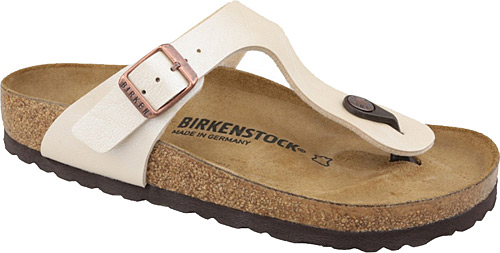Who discovered Birkenstock's technology based on the shape of the sole of the foot?
Founded in Langen-Bergheim in 1774 by shoemaker Johann Adam Birkenstock, the company opened its first factory in 1925. It is still owned by brothers Alex and Christian Birkenstock, grandchildren of the founder, and continues to manufacture all its shoes in Germany.

Birkenstock's history, dating back to 1774, began with shoemaker Johann Adam Birkenstock's dedication to his craft. The shoe craft was passed down from generation to generation, including Konrad Birkenstock, Johann Adam's great-grandson. Thanks to Konrad's visionary perspective, the new ideas he developed allowed him to produce and sell shoes with flexible soles. These new ideas he developed earned Konrad the title of inventor of the Footbed.
Birkenstock Group B.V. & Co. KG is a German shoe manufacturer known for its production of Birkenstocks, a German brand of sandals and other shoes notable for their contoured cork footbeds (soles) made with layers of suede and jute, which conform to the shape of their wearers' feet.
This title and innovative ideas have played an important role in the fate of the company and have greatly contributed to the popularity of Birkenstock shoes. Today, Birkenstock is a global shoe brand that offers quality, functionality and comfort to all its consumers. It is one of the largest manufacturers of the German shoe industry, with a sales network in more than 100 countries, with over 4,000 employees worldwide.
Johann Adam Birkenstock (also Birckenstock, Birkenstok, Berkenstock; 1 February 1687 – 26 February 1733) was a German composer and violinist. He was regarded as one of the foremost violinists of his day.
The Little-Known History of Birkenstock
In 1897, Johann's grandson Konrad Birkenstock developed a concept that would literally change the shape of the shoe. Although the soles of our feet were curved, the inside of the shoes was always flat. Konrad theorized that greater comfort would be possible if the shape of the shoes reflected the shape of the feet. Konrad designed the first shoe with contoured insoles for use by shoemakers in the manufacture of custom shoes.
In 1902 Konrad Birkenstock developed the first flexible arch support to be attached to factory-made shoes, which was widely distributed in Germany. Carl Birkenstock later joined the company. Birkenstock arch supports are currently exported to Austria, Switzerland, France, Italy, Belgium, Czechoslovakia, Netherlands, Luxembourg, Denmark, Sweden, and Norway.
The brand grew rapidly in 1932 as educational seminars and conferences spread throughout European countries, and leading medical professionals promoted the Birkenstock company's slippers and shoes at their seminars. In 1964, Carl Birkenstock's son Karl took his grandfather's concept of curved arch support a step further and the Birkenstock sandals came into existence.
While on vacation in Germany in 1966, Margot Fraser wanted to relieve foot fatigue from painful shoes and hard pavement. At a spa, someone suggested she try Birkenstocks. Birkenstock sandals felt good on Margot. Moreover, she realized that the chronic foot pain she had endured for years had disappeared a few months after returning home to California. Confident of its health benefits, Birkenstock began importing shoes to the United States, and Birkenstock USA was born. Birkenstock's popularity continued to grow with promotional campaigns in the 1970s. In the early 1980s, Birkenstock became a common word across the country. Birkenstock offered nearly 300 style/color combinations in 1996, and the shoes were distributed to millions in the United States.
It has become a well-known name with numerous distributors and stockists around the world. In the late eighties, Birkenstock took measures to reduce the environmental impact of the brand's operations, switched to environmentally friendly adhesives and updated its manufacturing processes to reduce energy consumption by 90%. These efforts were unprecedented in shoemaking and set the benchmark for brands worldwide. In 1997, Margot Fraser and Birkenstock USA received many prestigious awards from the shoe industry. Its unique shape pioneered the idea of function after form.
The story, which began with Johann Adam Birkenstock's invention of the sole, ended with these durable sandals that helped to heal common foot problems, keeping feet feeling as comfortable as possible for hours. Birkenstock still continues to develop shoes that support health and well-being.
February 2021
The Birkenstock brothers began seeking new investment late last year as they sought to continue expansion in new markets, including China and India.
L Catterton is the preferred bidder for his expertise in bringing brands to Asia and his knowledge of the fashion market, but the company has yet to complete its bid.
Private equity firm CVC Capital Partners, which owns dozens of companies from highway services firm Moto to luxury watchmaker Breitling, is vying with L Catterton, a private equity firm owned by Louis Vuitton and Christian Dior, to buy a majority stake in Birkenstock. LVMH. L Catterton already owns fashion brands such as Ganni, Seafolly, and Pepe Jeans.
HISTORY & HERITAGE
https://www.birkenstock.com/us/us-about-history.html
